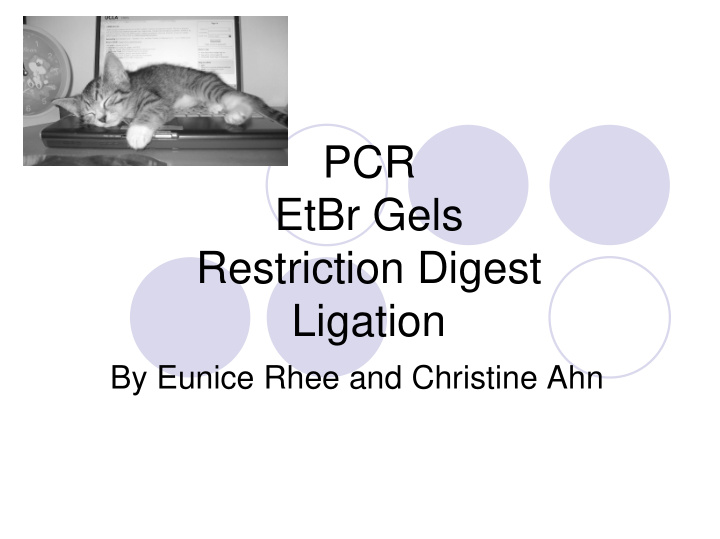



PCR EtBr Gels Restriction Digest Ligation By Eunice Rhee and Christine Ahn
I. Polymerase Chain Reaction (PCR)
PCR: Why do we do it? � Developed in 1983 by Kary Mullis � Amplify copies of DNA � Also used in… � Sequencing of genes � Identification of genetic fingerprints � Diagnosis of diseases
PCR: How do we do it? � 1. Denaturation of double-stranded target DNA (by heat, 95°C) � 2. Annealing of primers to single-stranded DNA (by cooling, approx. 55°C) � 3. Elongation of DNA strands to make new DNA molecules (always 72°C)
PCR: Thermostable Polymerases � Taq DNA polymerase (first isolated from Thermus aquaticus , a hot springs bacterium) is a thermophilic DNA polymerase used because it can withstand high temperatures. � Maximal catalytic activity ranges around 75 to 80°C � Magnesium ion is needed to shield negative charges � Pfu DNA polymerase (from Pyrococcus furiosus ) seems to have the lowest error rate out of the thermophilic DNA polymerases
PCR: Procedure � 1. Obtain forward and reverse primers � 2. Prepare four reaction tubes: � Tube 1 – 0 ul Mg, 40.6 ul RNAse-free water � Tube 2 – 1 ul Mg, 39.6 ul RNAse-free water � Tube 3 – 2 ul Mg, 38.6 ul RNAse-free water � Tube 4 – 3 ul Mg, 37.6 ul RNAse-free water � All tubes also contain 1ul forward primer, 1ul reverse primer, 5ul polymerase buffer, 1ul polymerase, 1ul template (i.e., E.Coli ), and 0.6ul dNTPs
PCR: Procedure � 3. Transfer each reaction tube mixture to PCR tubes � 4. Place tubes in thermocycler and set timer and temperatures to allow DNA to denature, anneal, and elongate.
II. Gel Extraction and Ethidium Bromide Gels (EtBr)
Gel Extraction: Why do we do it? � Verify to check if you have the target DNA � Separate target DNA from other strands or PCR products (purify DNA)
Gel Extraction: Procedure � 1. Prepare DNA agarose gel and wells � 2. Obtain tubes used for PCR � 3. Add 10% of DNA SLB (Ethidium Bromide dye) � 4. Insert ladder in well 1 � 5. Fill next well with first tube, and proceed the same way with the remaining tubes � 6. Raise voltage to 100V for 25 minutes
Gel Extraction: Procedure � 7. Observe where bands are by comparing it to the ladder � 8. Take photo of gel, then cut each band out and place them each into separate 1g microcentrifuge tubes and weigh them (to see how much QG to add) � 9. Add QG buffer � (solubilization & binding buffer)
Gel Extraction: Procedure � 10. Heat at 50°C for 15 minutes to allow agarose to melt. � 11. Transfer to purple binding columns and centrifuge at max speed for 1 min. (wash out QG) � 12. Add wash buffer (PE) and centrifuge at max speed for 1 min. � 13. Dump out elute, then centrifuge for 1.5 min to remove all ethanol � 14. Transfer the filters to new centrifuge tubes and add 30ul of RNAse-free water � 15. Centrifuge for 1 minute and keep the purified DNA
PCR Blunt � High copy vector � Used for sequencing (make sure your insert is correct and present) � Bidirectional � Simple and fast!
1 2 Direction does not matter! 2 1 Blunt ends 2 1
1 uL salt sln 4 uL insert 1 uL PCR Blunt (15 min) (2 uL)
If results are (+)…… Send to sequencing……
Expression Vector (pETM11) � Low copy � Used for expression….protein analysis � Restriction digest! � Unidirectional � Takes longer, more complex
Restriction Digest 10 uL pETM11 40 uL Insert 1 uL RE1 1 uL RE1 1 uL RE2 1 uL RE2 5 uL Buffer 3 uL Buffer 33 uL RNase free H20 5 uL RNase free H20 Total: 50 uL Total: 50 uL Digest O/N…
Restriction Enzymes � Available in our lab: � Nco I � EcoR I � Hind III � BamH I � Xho I � Nde I Palindromic sequences!
Recommend
More recommend